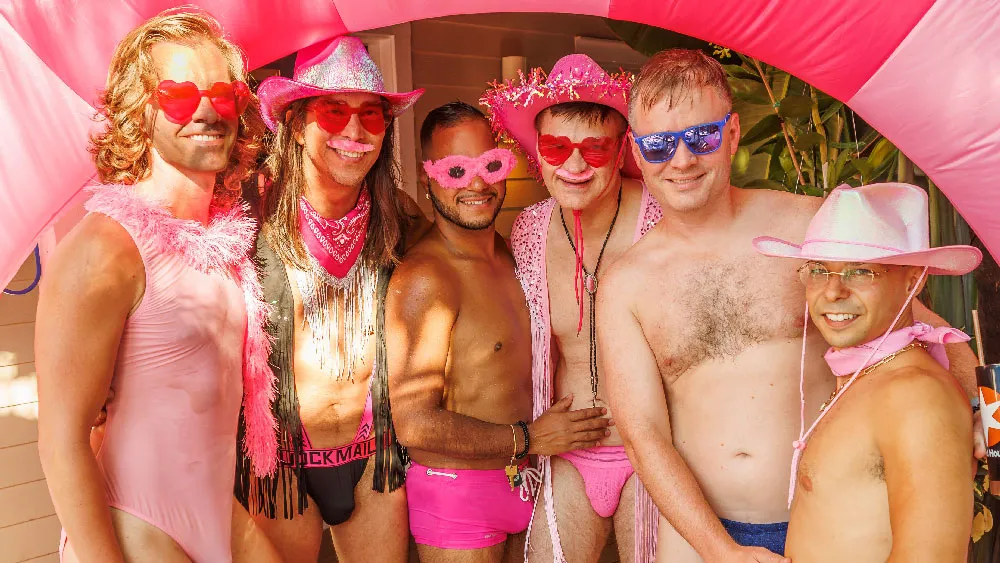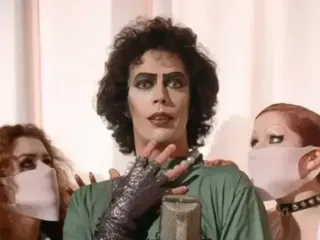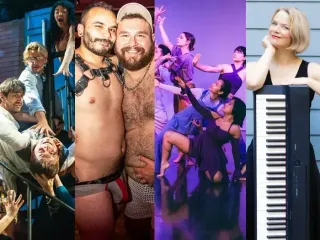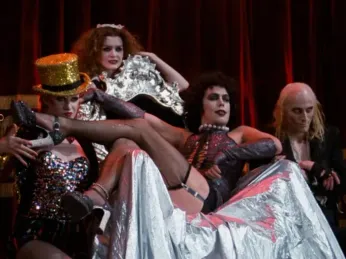
Sep 21
‘Strange Journey’ – ‘Rocky Horror Picture Show’ documentary’s a family affair
Jim Provenzano READ TIME: 1 MIN.
It may not be unusual for a filmmaker to make a documentary about his father. But when your father is the creator of “The Rocky Horror Show” and its cult film adaptation, things are a little bit different. For Linus O’Brien, he’s struck gold with “Strange Journey: The Story of Rocky Horror,” a moving tribute to his father Richard O’Brien’s creation, the musical that became a cult favorite in cinemas for 50 years. It remains the longest-running theatrical cinema release in the world. To celebrate its anniversary, O’Brien (Yes, he’s named after the Peanuts character) interviews his father, and nearly all the living cast and lead crew members.
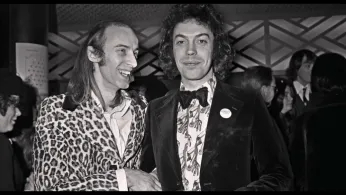
Unlike some documentaries on the film from previous years, O’Brien managed to get interviews with Sarandon (Janet Weiss), who is often reluctant to join the celebrations. Barry Bostwick (Brad Majors), Nell Campbell (Colombia), Patricia Quinn (Magenta), and Tim Curry (Frank-N-Furter), even Peter Hinwood (Rocky) are among those who describe their early years with the film, and for some the initial musical as well. And of course, Richard O’Brien (playwright, composer, Riff Raff) shares his creative inspirations and sings a few acoustic versions of his songs. Guest commentators include actor Jack Black and drag star Trixie Mattel.
A history of the development of the play, its critical success in London, which failed in America, is followed by the making of the film in 1975. Shot mostly in a damp cold castle in England, justified complaints were made about shooting conditions. Sarandon has often been quoted about the cold, but admitted that the low budget gave it a sense of edginess.
The film also focuses on the midnight screenings after the film’s flop release. Smartly devised to appeal to the colleges-age set, it was at the Waverly Theater in lower Manhattan where the first interactive hilarious shenanigans started to take place. The development of shadow casts, who mimic the onscreen characters and action in theater aisles, is credited to have been pretty much nurtured by the film fan club president, then late Sal Piro.
And now decades later, Linus O’Brien talked about his inspiration for making the film about the film.
Jim Provenzano: Linus, this is kind of a lifetime experience, because you were literally running around on the set for the film as a toddler, and had a small role in the sequel, “Shock Treatment.”
Linus O’Brien: Yes, apparently, I was on the set for “Rocky Horror,” but I don’t remember it because at that stage I was probably two.
The documentary has a very professional feeling, considering the subject.
It’s nice of you to say, because that was the intent, was to make something that was as professional and as slick and just as well made as possible. Because I think the tendency may be for people who were thinking a documentary about “Rocky Horror” would be made in a kind of rough-and-tumble handmade style. And I didn’t want to do that.
I’m impressed that you got interviews with every living cast member, the director Jim Sharman, producer Lou Adler and costume designer Sue Blayne. Was that difficult, or since you’ve known them so long, was it easier to get people on camera?
It was a little bit challenging, like 5%. It really wasn’t difficult. Obviously, me being the director helped a few of those things, but it was really down to also my team as well. Tim Curry wasn’t difficult to get, but scheduling was a little bit difficult with him. For Peter Hinwood, there was a little bit of back and forth on Instagram with him, telling him, “There’s no pressure; come down, have a good time.” So yeah, it was just a little bit of very gentle cajoling really. I grew up a lot around a lot of them, especially Nell and Pat when I was up to the age of 10. It was great to catch up with them after all these years.
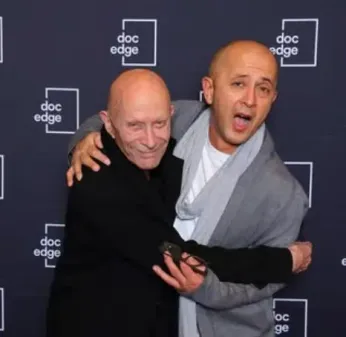
Along with screening in San Francisco starting September 25, you’ve also entered the film in several festivals.
Yeah, Bolinas is almost the last one. I think we’ve got one in Rome, which is in the middle of October. But other than that, it was kind of it, because obviously it gets released in US theaters and then in UK theaters on October 3.
A unique portion of this, obviously, is your father telling stories and singing a few lovely acoustic versions of songs from the score, as well as his personal struggles, his journey and his struggles.
What an amazing way to be able to celebrate my dad’s life and his work and then talk a little bit about his journey, which took probably 30 years longer than most other people who went to see “Rocky” in the ’70s. That’s very ironic, in a way. Here is the person responsible for bringing transvestites, transsexuality and bisexuality to the screen in a major way and to the stage, and yet he himself struggled with how he identified himself. I mean, at this point, after 30 years, he finally said, “I feel 30% female and 70% male most of the time.”
And for him to admit that to himself obviously releases a lot of pressure that he was putting on himself, and then also makes him more relaxed around his family and friends. The capper of all of it, that he was able to find true love later on in his life with his now-wife, Sabrina Graf [his third wife]. It’s almost like a bit of a fairy tale, really for him. So yeah, it’s been really lovely. And then doing the joint interviews with him for some publications has also been a really nice experience.
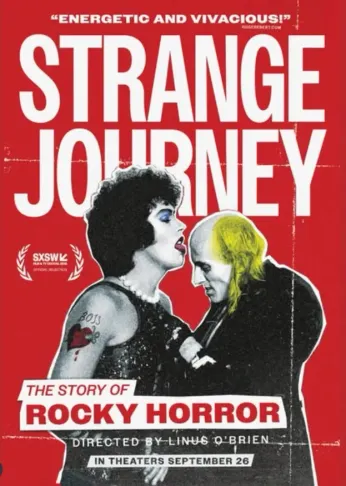
In the film, you’re very professional, but it does get very touching and sweet in several moments.
He’s hesitant to go there sometimes, especially during the day. In the evening, he gets a little bit more sentimental, so we just wanted to capture just a little bit of his more sensitive side, and I’m really glad we did. The first time where he talks about his struggles in his early childhood, that comes right after Tim and my dad both discuss [the song] “Sweet Transvestite.”
We’re talking about the stage play and the run-up to the stage play, and then we cut into my dad talking about his journey, and it’s just a really lovely bit of placement, because it’s right after his story, then we go into [producer] Lou Adler and the film. So yeah, placing those moments can be crucial to the way they land, basically.
Most devoted fans know a lot of the lore, but you got some new stories in.
Some stories may be known; how Tim got his accent for Frank, and Patricias head in a clam; those might be quite well known to “Rocky” fans. There are lots of little things in there which they would have no idea about. So yeah, the story of “Rocky” has never been told on this scale before, and that’s what we tried to achieve.
You’ve met many shadow cast performers. For a few months in 1979 in college, I played Brad Majors. But the irony was, I was the only gay guy in the entire shadow cast. Everyone else was straight.
Isn’t that funny? But isn’t that the way? That’s the beautiful thing about “Rocky,” the shadow casts and the theater productions. Gender takes a backseat, how you lean sexually takes the backseat, and it just becomes, you’re doing Rocky. It’s just all complete freedom, really. I think that’s the beauty of it.
I found the restrictions of it actually fascinating in that we were doing a kind of Kabuki performance. Some of us actually sang. The hilarious thing is, of course, the floor show. Nobody has enough real time to get changed into the corsets and makeup.
The girls went behind the screen, and I’d rush behind an exit curtain with ‘Rocky,’ trying to catch a glimpse of him naked as we were changing in two minutes, slapping on clown white and tugging on fishnets. That was the biggest challenge. The rest of it was just getting squirted by water and called “asshole,’ a lot.
How did you choose how much vintage footage of the early shows and the fandom?
It was very challenging in terms of time, because my creative partner and I, Avner Shiloah, wanted to keep the film to 90 minutes. It was very important for us to do that. We felt like you could tell the story in that time, and there’s something to be said about economy of storytelling.
But at the same time, we had a lot of challenges to make that happen, to tell my dad’s personal journey, to tell the history of “Rocky” itself, to factor in the midnight screenings and the results of that. I would like to have spent a bit more time with the modern-day shadow casts, but we were kind of up against it.
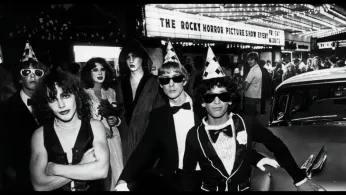
But the placement of that right at the end, and then having people reflect on basically what that shadow cast segment meant, gives it the weight and power it deserves. What is essentially a seven-minute segment is short, but what people say is incredibly profound and on point. Also, the placement of it right at the end of the movie gives the modern-day shadow cast their moment, and affects essentially the ending of the movie.
The moments that are left in really rise to the top and have that much more resonance because obviously a reason you kept one over the other; it’s usually because it’s stronger and it works better in the overall scope of the film. Getting that balance right between everything was tricky, but I really think we managed to do it.
When we show it in festivals, you can tell people are locked in right from the beginning, and their attention is held throughout the entire film. And I think as a filmmaker, that’s exactly what you want.
How many of us really see documentaries in the theater with other people anyway? It’s very small. And then to have it seen with a bunch of people and have them cheer and cry and laugh throughout the whole movie; it’s been like a really amazing experience.
Most of the actors have visited and toured for screenings, and there’s an official tour with this 50th anniversary where this year, Nell Campbell is coming to speak at the Curran Theatre in San Francisco in October. Previously, Patricia, Nell and Barry visited. In January, Tim came up from LA and Peaches Christ lauded him with drag queens doing numbers, in a big tribute. It was just so wonderful to see him again, to see him after the stroke, to be so ready to do this.
Obviously, it’s been a struggle for him and he comes across quite well, but it obviously it takes a lot of energy, I think at the same time, to really muster it all up so he can feel confident in his coherence and his wit, which comes through. So yeah, we’re very, very lucky to be able to have him involved and for him to feel included in the 50th celebration.
Some people may be shocked when they first see him because obviously the difference between him now and when he performed as Frank is startling. And obviously there’s some sadness in there too, let’s be real. Here is probably one of the most iconic performances of all time in stage and film, and to see him slightly diminished now, it really highlights how little time we have on the planet.
Well, at least this planet, if they're not going to fly off to another one like Riff Raff and Magenta.
Right!
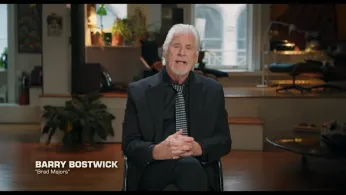
Was it director Jim Sharman who said, speaking of special effects, he said he wanted them to look deliberately bad like an old science fiction movie?
Yes, it was Jim. It was funny because he said some of those moments that you see were deliberate, and some of them were because they were on a B-movie budget, although he couldn’t tell you which were which. And what did he say at the end? “Life is full of contradictions, and so is ‘The Rocky Horror Picture Show.’”
What’s interesting is how the audience callbacks have evolved over the years.
I think that’s the beauty of it, those callbacks; they come in and out of fashion. Some obviously that remain evergreen. There’s one with my dad as well, where after killing Frank, Rocky, Magenta says, “They liked you.” And in the pause before Riff Raff shouts, “They never liked me!” someone shouts, “Go for the Oscar!” [laughter] It was amazing. It was so just amazing.
Some live performances are odd with the musical versions because people want to bring the film into it. Even some of the classic callbacks sometime don’t work in live musical performances. Performers know to expect or encourage them. When Frank sings, “Whatever Happened to Fay Wray?” once when I called out the familiar callback, “She went ape-shit!" no one got it, or they didn’t want it.
Yes, the stage show has kind of become a bit more like the movie, actually. The callbacks have kind of entered the UK tour a lot more, which they never were before. The original stage play was much, much darker and ominous than a feeling of dread when you entered the theater, and now it’s a little bit more Broadway, I guess, actually.
Did your father change the script when it was reproduced?
It didn’t change that much. I don’t think that they took things from the script of the movie and put them in there, although they might have. I think the biggest change is –we talk about it in the documentary– they just flipped the positioning of “The Time Warp” and “Sweet Transvestite.” I’m not sure what year that happened, but that was the major change.
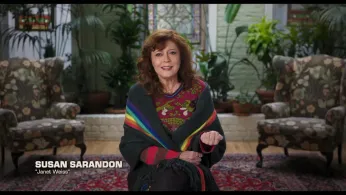
But it’s funny to be at a live show and see the actors pause for a callback, and if nobody does it, it kind of clunks and falls to the ground.
It’s become very much like English pantomime, if you’re familiar with that. American audiences don’t really have that. At Christmas time, the pantomimes would be very, very raucous, interactive theater, basically.
The score of “Rocky Horror” is such a bundle of earworms.
Even though its subject matter, and the style of the songs might be a bit trashier than your regular Broadway musical, that doesn’t take away their catchiness and their longevity. It's been a thrill to really highlight some of them within the documentary.
Yeah, with my father’s love of ’50s rock and roll, and obviously the times that they were actually written, which is Beatles and Rolling Stones, and all of that stuff. That’s all in there, so you have these cross-pollinated genres of glam rock and traditional rock and roll and ’50s rock and roll all mixed in together. And then you have those beautiful ballads at the end, I mean “Superheroes” and “I’m Going Home,” are amazing songs which I've really come to appreciate.
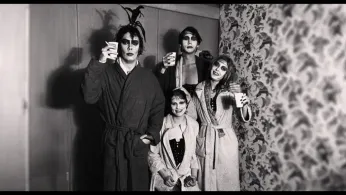
It really is unique in so many ways.
The legacy of “Rocky Horror,” you can say, is the music, Tim’s performance, people finding their own sexuality, even. But I think really what it boils down to at the end is community and connection. And I think that those two words are just the key insight into the sustaining legacy of “Rocky.” The fact that people are able to meet other people like themselves who feel a bit different, who don’t feel like they quite fit into society regardless of how they see themselves sexually, is its greatest gift to the world.
‘Strange Journey: The Story of Rocky Horror’ plays at the Balboa Twin (38th at Balboa) and Rialto Cinemas Elmwood (2966 College Ave., Berkeley) Sept. 25 & 26.
https://rockyhorrordoc.com/
